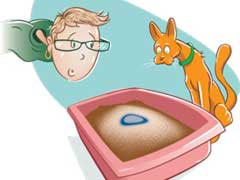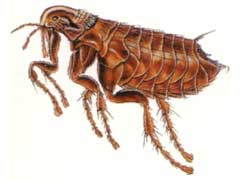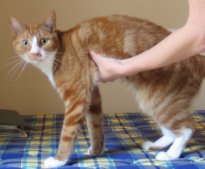
Cats
Neck or back pain is discomfort along the spine. This pain may be mild and associated with subtle clinical signs, such as reluctance to jump or climb stairs. For some animals, the pain may be excruciating and associated with crying or moaning, reluctance to move, decreased appetite and malaise.
Back pain must be differentiated from diffuse pain arising in nearby tissues. When pain is present in the abdominal organs and the abdominal muscles, it may be difficult to distinguish such pain from actual back pain. Even a thorough examination by your veterinarian may not be able to always localize the pain, particularly because animals cannot describe their pain or identify for us where it is at its worst.
There are a variety of causes of neck and back pain and they include muscle diseases, vertebral disorders, nerve problems, etc. Examples include the following:
Evaluation of the cat with neck or back pain begins with a complete medical history and a thorough physical examination. An extensive neurologic examination may also be indicated. If the pain can be localized to the neck or back, then several tests may be recommended to further investigate the possible cause of the pain. Such tests include the following:
Treatment varies widely for patients with back or neck pain, depending upon the nature of the disease and the extent of the tissues involved. It is important to realize that with the exception of strict rest, there is very little that owners can do symptomatically for these patients at home. It is important for your veterinarian to identify a specific cause, then appropriate treatment plans can be devised for each animal.
Depending on the severity of signs, treatment may be provided on an outpatient basis or may necessitate hospitalization. Treatments may involve medication, surgery or both.
Response to therapy should be monitored closely and adjustments made as necessary. Administer all prescribed medications and return for follow up evaluations as directed by your veterinarian. Report any and all changes to your veterinarian.
Keep your pet in an environment that minimizes excessive movement, and do not exercise your pet without permission from your veterinarian. The prognosis for animals with back pain varies widely. Some causes are readily treatable, while others are more serious and life threatening.
 Top 5 Cat Urinary Tract Infection Home Remedies
Cat ur
Top 5 Cat Urinary Tract Infection Home Remedies
Cat ur
 Bald Spots on Cats
Bald Spots on Cats Bald spots are a common occurrence in cat
Bald Spots on Cats
Bald Spots on Cats Bald spots are a common occurrence in cat
 Cat Fleas on Humans – How To Avoid Getting Bitten?
Cats m
Cat Fleas on Humans – How To Avoid Getting Bitten?
Cats m
 5 Important Things To Do For Cat Hairball Prevention
Hairba
5 Important Things To Do For Cat Hairball Prevention
Hairba
 Anaphylaxis in Cats
Anaphylaxis in Cats Also known as allergic shock, anaphylasi
Anaphylaxis in Cats
Anaphylaxis in Cats Also known as allergic shock, anaphylasi
Copyright © 2005-2016 Pet Information All Rights Reserved
Contact us: www162date@outlook.com